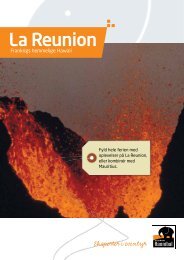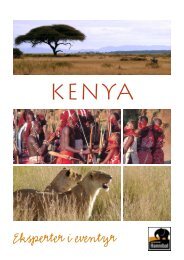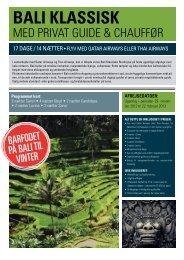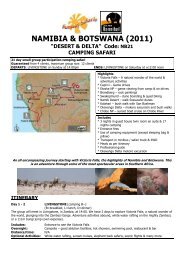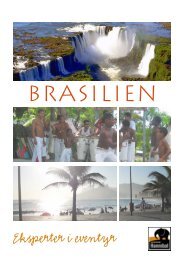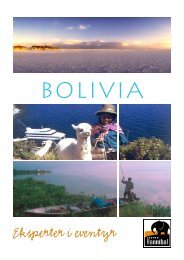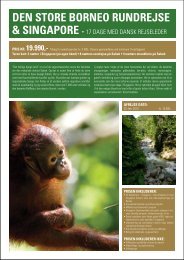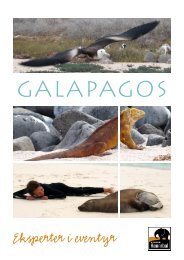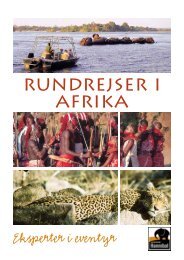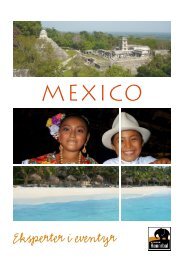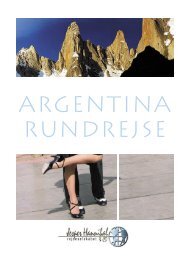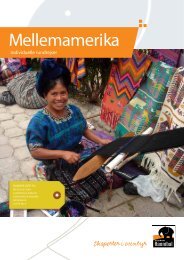15 Day Intimate Zimbabwe Lodge Safari A fully ... - Jesper Hannibal
15 Day Intimate Zimbabwe Lodge Safari A fully ... - Jesper Hannibal
15 Day Intimate Zimbabwe Lodge Safari A fully ... - Jesper Hannibal
Create successful ePaper yourself
Turn your PDF publications into a flip-book with our unique Google optimized e-Paper software.
Version: 2012<br />
Tour Code: IZL<br />
Great <strong>Zimbabwe</strong><br />
Construction starting in the 11th century and continuing for over 300 years, the ruins at<br />
Great <strong>Zimbabwe</strong> are some of the oldest and largest structures located in Southern<br />
Africa. At its peak, estimates are that the ruins of Great <strong>Zimbabwe</strong> had as many as 18,000<br />
inhabitants. The ruins that survive are built entirely of stone. The ruins span 1,800 acres<br />
(7 km²) and cover a radius of 100 to 200 miles (160 to 320 km).<br />
The ruins can be broken down into three distinct architectural groups. They are known as<br />
the Hill Complex, the Valley Complex and the famous Great Enclosure. The Hill Complex<br />
was used as a temple, the Valley complex was for the citizens, and the Great Enclosure<br />
was used by the king. Over 300 structures have been found so far in the Great Enclosure.<br />
The type of stone structures found on the site gives an indication of the status of the<br />
citizenry. Structures that were more elaborate were probably built for the kings and<br />
situated further away from the center of the city. It is thought that this was done in order<br />
to escape sleeping sickness.<br />
What little evidence exists suggests that Great <strong>Zimbabwe</strong> also became a center for<br />
trading, with artifacts suggesting that the city formed part of a trade network extending<br />
as far as China. Chinese pottery shards, coins from Arabia, glass beads and other nonlocal<br />
items have been excavated at <strong>Zimbabwe</strong>.<br />
Nobody knows for sure why the site was eventually abandoned. Perhaps it was due to<br />
drought, perhaps due to disease or it simply could be that the decline in the gold trade<br />
forced the people who inhabited Great <strong>Zimbabwe</strong> to look for greener pastures.<br />
Nyanga National Park<br />
Nyanga (formerly known as Inyanga) is a town in the province of Manicaland,<br />
<strong>Zimbabwe</strong>, located adjacent to Nyanga National Park in the Eastern Highlands about<br />
105 km north of Mutare. According to the 1982 Population Census, the town had a<br />
population of 2,973. The highest mountain in <strong>Zimbabwe</strong>, Mount Nyangani lies about <strong>15</strong><br />
km from the village. Its highest peak rises to 2,600 m above sea level. Nyanga is a popular<br />
tourist destination with its trout fishing, golf courses, mountain hikes and holiday resorts.<br />
Nyanga also accommodates the highest waterfalls in the country - the Mtarazi Falls are<br />
about 760 m high. The surrounding areas also contain many Stone Age and Iron Age<br />
archaeological remains such as pit structures, stone forts, terraces and pathways.<br />
In the town is the bustling township of Nyamhuka, around which there is an ever<br />
expanding growth of high and medium density housing.<br />
The Nyanga Area has long been regarded as a place of great natural beauty. In 1896,<br />
Cecil John Rhodes wrote to his agent: "Dear McDonald, Inyanga is much finer than you<br />
described...Before it is all gone, buy me quickly up to 100 000 acres [400 km²], and be<br />
sure to take in the Pungwe Falls. I would like to try sheep and apple growing."<br />
Mana Pools<br />
Mana Pools is a wildlife conservation area in Northern <strong>Zimbabwe</strong> constituting a National<br />
Park. It is a region of the lower Zambezi River in <strong>Zimbabwe</strong> where the flood plain turns into<br />
a broad expanse of lakes after each rainy season. As the lakes gradually dry up and<br />
recede, the region attracts many large animals in search of water, making it one of<br />
Africa's most renowned game-viewing regions.<br />
Mana means ‘four’ in Shona, in reference to the four large permanent pools formed by<br />
the meanderings of the middle Zambezi. These 2,500 square kilometres of river frontage,<br />
islands, sandbanks and pools, flanked by forests of mahogany, wild figs, ebonies and<br />
baobabs, is one of the least developed National Parks in Southern Africa. It was saved<br />
from a hydro-electric scheme in the early eighties which would have seen the flooding of<br />
this subsequent World Heritage site.



